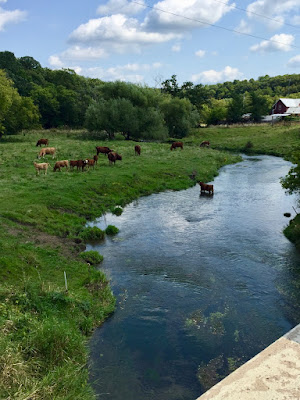This year’s theme is “Recovering key species for ecosystem restoration.”
Continued loss of species, habitats and ecosystems also threatens all life on Earth, including us. People everywhere rely on wildlife and biodiversity-based resources to meet all our needs, from food, to fuel, medicines, housing, and clothing. Millions of people also rely on nature as the source of their livelihoods and economic opportunities.
The United Nations is emphasizing protecting “the most critically endangered species.” I would suggest, in light of the recently issued IPCC Sixth Assessment Report, we are all in or very near that condition.
 |
| habitat for trout, shared with ...
Photo by J. Harrington
|
For much of my adult (using the term loosely) life, I’ve been a member of an organization, Trout Unlimited, that's focused on protecting and restoring cold water habitats and the creatures that live therein. As the TU web site notes: Our mission is to bring together diverse interests to care for and recover rivers and streams so our children can experience the joy of wild and native trout and salmon.
Some of that work is going on now and nearby. In particular, TU is working with partners like the City of River Falls, to help remove two dams on the Kinnickinnic River and restore the in-stream and adjacent habitat. The Kinni, the most downstream tributary of the St. Croix, is located near the northern edge of the Driftless Area. According to one of the papers presented at a 2019 Driftless Area symposium on a “Plan for Resiliency in an Uncertain Future:”
1. The Driftless Area is expected to experience higher temperatures and more intense and frequent rainfall events as climate changes (high certainty).
2. Soil moisture is expected to decline, especially when droughts occur, but effects may be offset by increases in precipitation.
3. Trout distributions are predicted to decline with warming stream temperatures, and the way species interact (e.g., Brook Trout Salvelinus fontinalis and Brown Trout Salmo trutta) will change in complex ways, such as being externally influenced by changing parasite-host relationships (e.g., gill lice Salmincola edwardsii).
4. Changes in precipitation frequency and intensity will change wa- ter:sediment balances in streams, altering stream stability and habi- tat for aquatic biota. These changes, such as flooding frequency, have been shown to influence trout population dynamics at a re- gional scale.
Removal of the dams on the Kinni is intended to help reduce temperatures in the lower river by 4 to 5 degrees. To learn more about protecting threatened wildlife in our backyards, and to help support restoration efforts, and have some fun at the same time, try attending one or both of these events:
- River Falls Flyfishing Film Festival, tomorrow, Friday, March 4
- The Great Waters Fly Fishing Expo, March 18 - 20, St. Paul
Fishing
The two of them stood in the middle water,The current slipping away, quick and cold,The sun slow at his zenith, sweating gold,Once, in some sullen summer of father and daughter.Maybe he regretted he had brought her—She'd rather have been elsewhere, her look told—Perhaps a year ago, but now too old.Still, she remembered lessons he had taught her:To cast towards shadows, where the sunlight failsAnd fishes shelter in the undergrowth.And when the unseen strikes, how all else palesBeside the bright-dark struggle, the rainbow wroth,Life and death weighed in the shining scales,The invisible line pulled taut that links them both.
********************************************
Thanks for visiting. Come again when you can.
Please be kind to each other while you can.
No comments:
Post a Comment